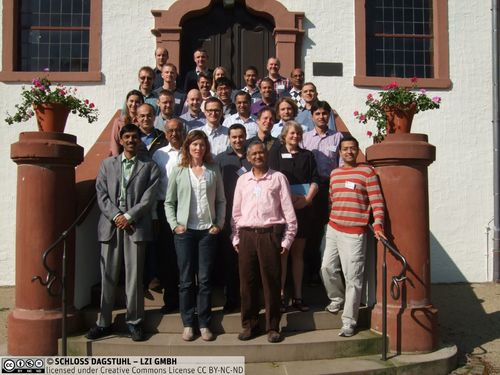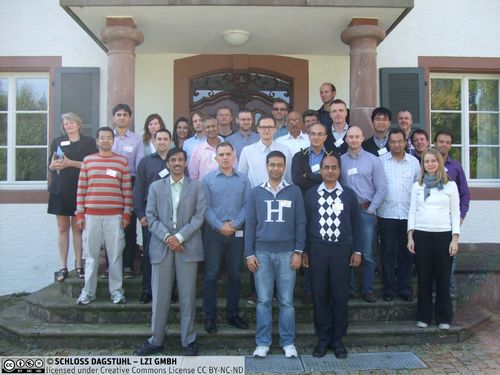Dagstuhl Seminar 13402
Physical-Cyber-Social Computing
( Sep 29 – Oct 04, 2013 )
Permalink
Organizers
- Ramesh Jain (University of California - Irvine, US)
- Amit P. Sheth (Wright State University - Dayton, US)
- Steffen Staab (Universität Koblenz-Landau, DE)
- Markus Strohmaier (Universität Koblenz-Landau, DE)
Coordinator
- Payam M. Barnaghi (University of Surrey, GB)
Contact
- Andreas Dolzmann (for scientific matters)
Schedule
Miniaturisation, progress with energy issues and cost reductions have resulted in rapid growth in deployment of networked devices and sensing, very strongly connecting the physical word with the cyber-world. The number of devices connected to the Internet already exceeds the number of people on earth and is estimated to grow to 50 billion devices by 2020. The resulting system called Internet of Things (IoT) incorporates a number of technologies including wireless sensor networks, pervasive computing, ambient intelligence, distributed systems and context-aware computing. With growing adoption of smart-phones and social media, citizens or human-in-the-loop sensing and resulting user generated data and data generated by user carried devices have also become key sources of data and information about the physical world and corresponding events. Data from all these sources will result in tremendous volume, large variety and rapid changes (velocity).
The combination of cyber-physical and social data can help us to understand events and changes in our surrounding environments better, monitor and control buildings, homes and city infrastructures, provide better healthcare and elderly care services among many other applications. To make efficient use of the physical-cyber-social data, integration and processing of data from various heterogeneous sources is necessary. Providing interoperable information representation and extracting actionable knowledge from deluge of human and machine sensory data are the key issues. We refer to the new computing capabilities that can exploit all these types of data as physical-cyber-social computing.
As the Web provided useful mechanisms to access and use new types of resources, techniques increasingly moved from syntactic and structural to semantic representations. There is also a recent resurgence of research towards Computing for Human Experience. This line of work has a long lineage, starting in part with Vannevar Bush's Memex through Mark Weiser's “Computing in the 21st Century” and others. But the essence of the vision incorporates technology that serves human needs without explicit human effort. This multidisciplinary seminar seeks to develop a vision of a new class of 21st century systems involving machines (physical), computing and communications (cyber) and human-centric and social systems (social). Several challenges arise in this context, including the following topics that will be discussed at this Dagstuhl Seminar:
- Examine emerging manifestations of physical-cyber-social computing and systems, including applications in such varied areas as health and well-being, social and human development, crisis management and transportation.
- How are emerging physical-cyber-social systems different than integration of cyber-physical systems with social systems as conceived today?
- How do physical-cyber-social systems utilise or benefit from the Web of Things/Internet of Things, Crowdsourcing, Collective Intelligence, Semantic Web/Semantic Sensor Web, Natural Interfaces, Ambient Intelligence and other technologies/ advances during the last decade.
- What novel disruptive applications are likely to result due to emerging physical-social-cyber computing after the initial obvious applications are addressed?
- What is the role of semantics in physical-cyber-social computing, and how do existing semantic and social computing techniques accelerate or constrain the emergence of physical-cyber-social systems?
- How do physical-cyber-social computing transform traditional perceptions of physical objects, online engagement and social interactions?
- What implications will the confluence of physical-cyber-social computing have on societies, including aspects such as citizen participation, democracy, open government, open government data and others?
Miniaturisation, progress with energy issues and cost reductions have resulted in rapid growth in deployment of networked devices and sensing, tightly connecting the physical word with the cyber-world as well as interconnected humans bringing along them virtual social interactions.. The number of devices connected to the Internet already exceeds the number of people on earth and is estimated to grow to 50 billion devices by 2020. The resulting system called Internet of Things (IoT) incorporates a number of technologies including wireless sensor networks, pervasive computing, ambient intelligence, distributed systems and context-aware computing. With growing adoption of smart-phones and social media, citizens or human-in-the-loop sensing and resulting user generated data and data generated by user carried devices have also become key sources of data and information about the physical world and corresponding events. Data from all these sources will result in tremendous volume, large variety and rapid changes (velocity). The combination of cyber-physical and social data can help us to understand events and changes in our surrounding environments better, monitor and control buildings, homes and city infrastructures, provide better healthcare and elderly care services among many other applications. To make efficient use of the physical-cyber-social data, integration and processing of data from various heterogeneous sources is necessary. Providing interoperable information representation and extracting actionable knowledge from deluge of human and machine sensory data are the key issues. We refer to the new computing capabilities needed to exploit all these types of data to enable advanced applications as physical-cyber-social computing.
 Amit P. Sheth and Payam Barnaghi and Markus Strohmaier and Ramesh Jain and Steffen Staab
Amit P. Sheth and Payam Barnaghi and Markus Strohmaier and Ramesh Jain and Steffen Staab
- Rajendra Akerkar (Vestlandsforsking - Sogndal, NO) [dblp]
- Harith Alani (The Open University - Milton Keynes, GB) [dblp]
- Pramod Anantharam (Wright State University - Dayton, US) [dblp]
- Payam M. Barnaghi (University of Surrey, GB) [dblp]
- Ciro Cattuto (ISI Foundation, IT) [dblp]
- Benoit Christophe (Bell Labs - Nozay, FR) [dblp]
- Edward Curry (National University of Ireland - Galway, IE) [dblp]
- Emanuele Della Valle (Polytechnic University of Milan, IT) [dblp]
- Schahram Dustdar (TU Wien, AT) [dblp]
- Frieder Ganz (University of Surrey, GB) [dblp]
- Michael Granitzer (Universität Passau, DE) [dblp]
- Manfred Hauswirth (National University of Ireland - Galway, IE) [dblp]
- Laura Hollink (VU University Amsterdam, NL) [dblp]
- Andreas Hotho (Universität Würzburg, DE) [dblp]
- Geert-Jan Houben (TU Delft, NL) [dblp]
- Ramesh Jain (University of California - Irvine, US) [dblp]
- Mohan S. Kankanhalli (National University of Singapore, SG) [dblp]
- Artem Katasonov (VTT - Espoo, FI) [dblp]
- Claudia Müller-Birn (FU Berlin, DE) [dblp]
- Josiane Xavier Parreira (National University of Ireland - Galway, IE) [dblp]
- Axel Polleres (Siemens AG - Wien, AT & Wirtschaftsuniversität Wien, AT) [dblp]
- RangaRao Venkatesha Prasad (TU Delft, NL)
- Matthew Rowe (Lancaster University, GB) [dblp]
- Amit P. Sheth (Wright State University - Dayton, US) [dblp]
- Vivek K. Singh (MIT - Cambridge, US) [dblp]
- Steffen Staab (Universität Koblenz-Landau, DE) [dblp]
- Markus Strohmaier (Universität Koblenz-Landau, DE) [dblp]
- Kerry Taylor (CSIRO - Canberra, AU) [dblp]
- Koji Zettsu (NICT - Kyoto, JP) [dblp]
Classification
- hardware
- semantics / formal methods
- society / human-computer interaction
Keywords
- Semantic sensor networks
- Web of Things
- Internet of Things
- semantic interoperability and context
- social computing
- collective intelligence
- situation-awareness
- human and machine perception
- computing for human experience
- social life networks
- da



 Creative Commons BY 3.0 Unported license
Creative Commons BY 3.0 Unported license
